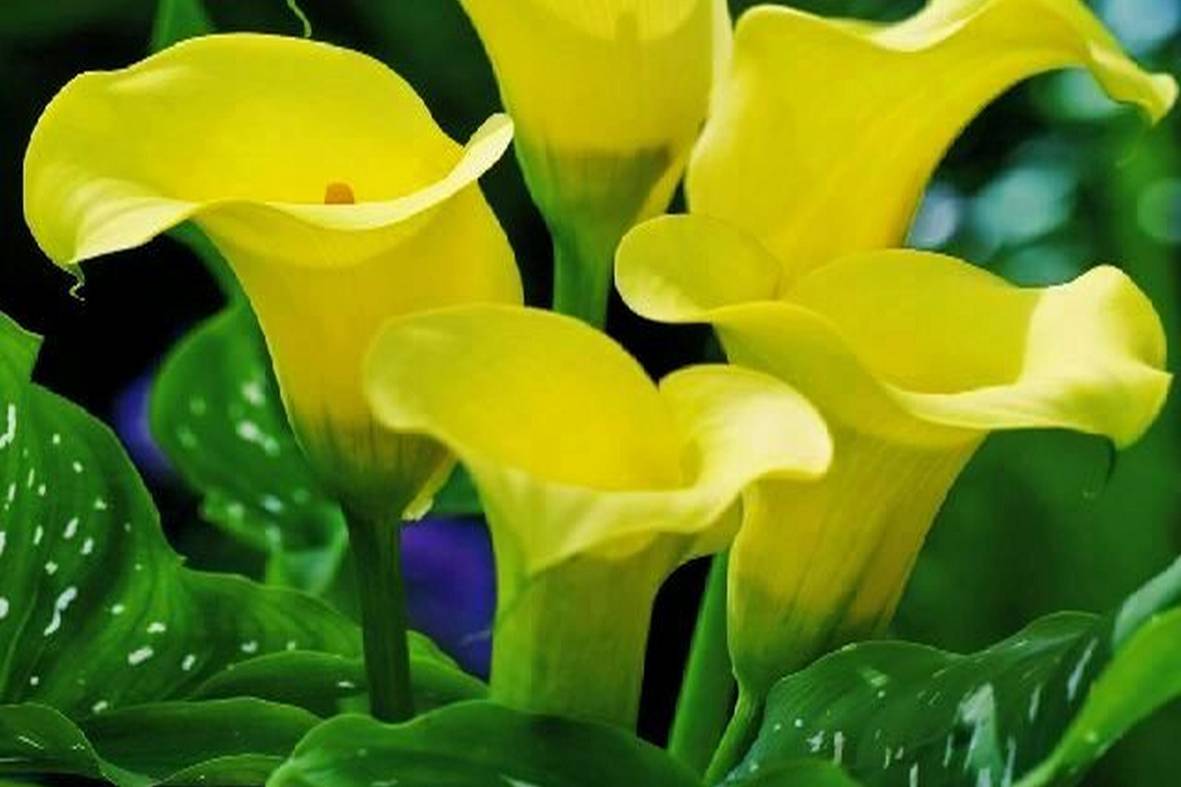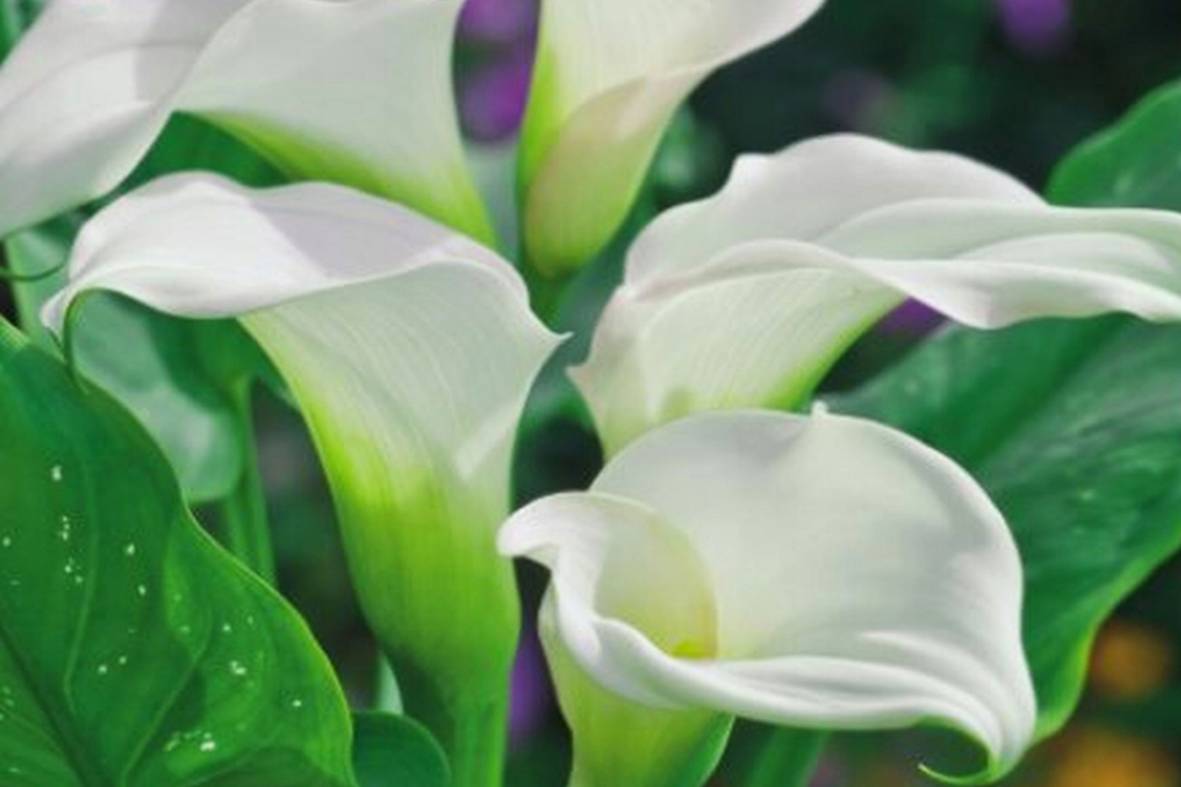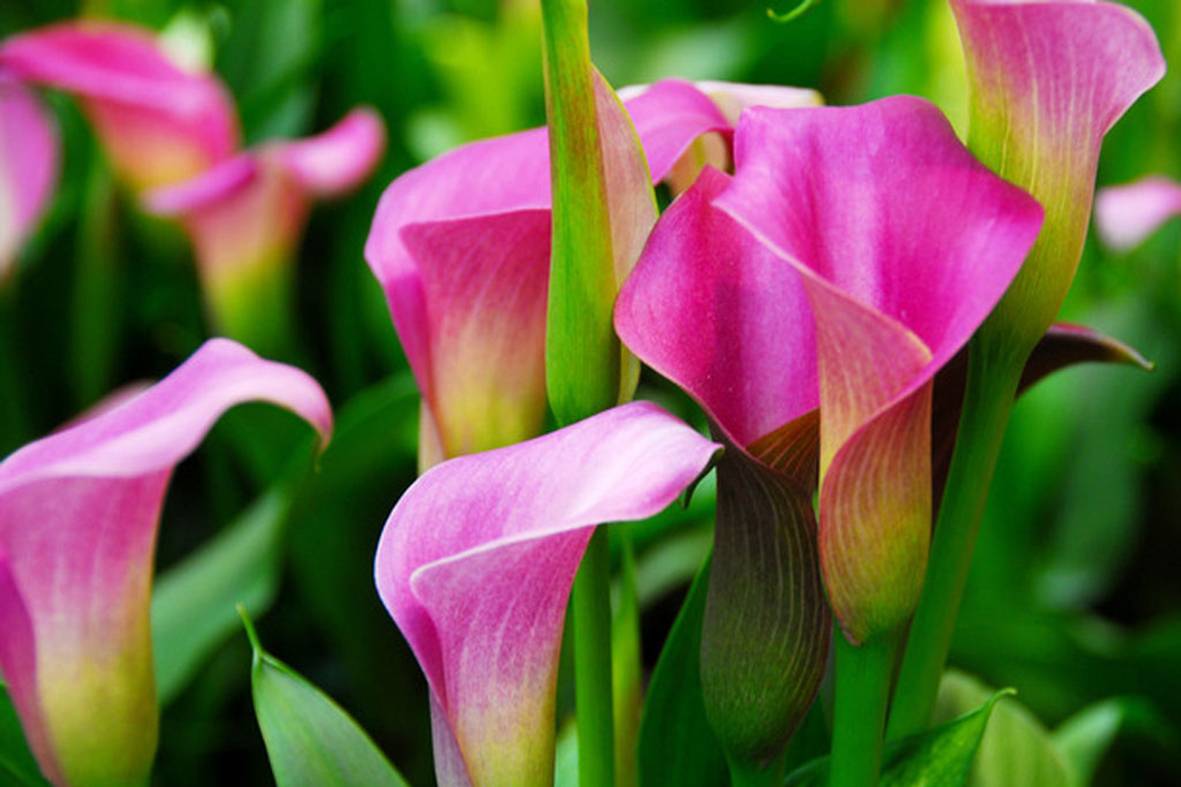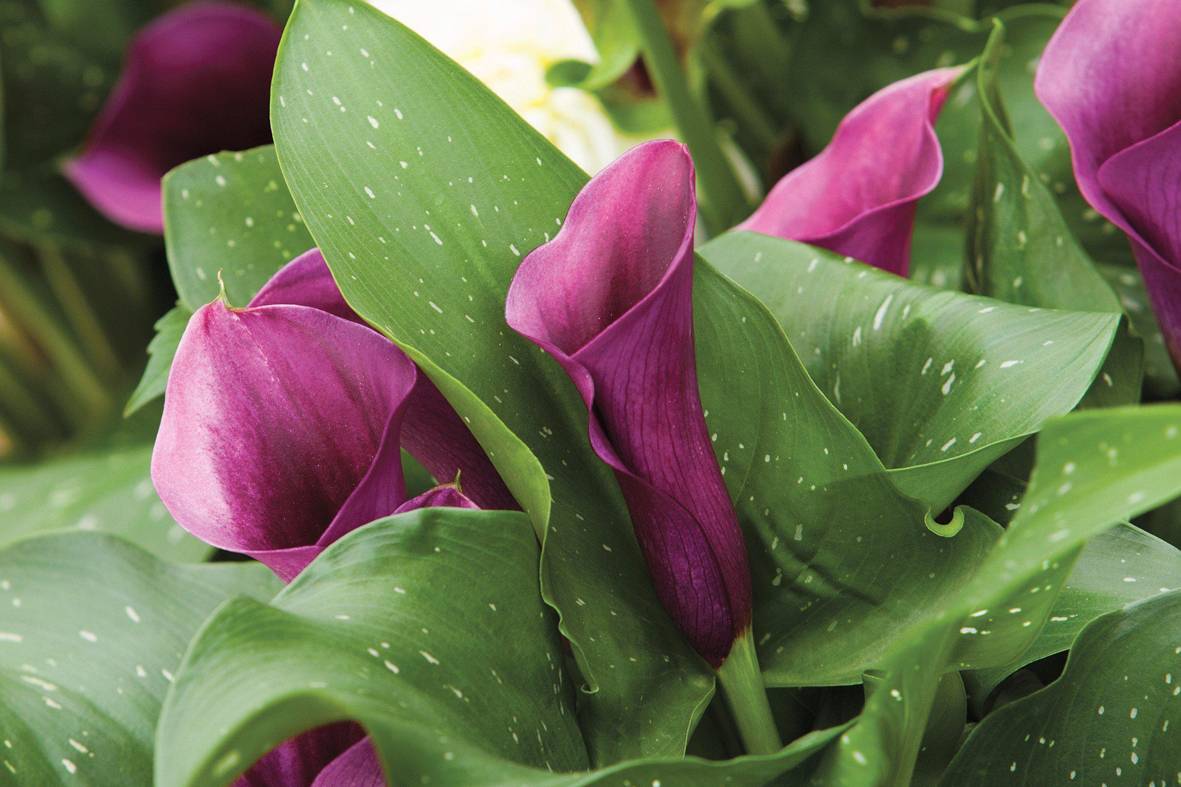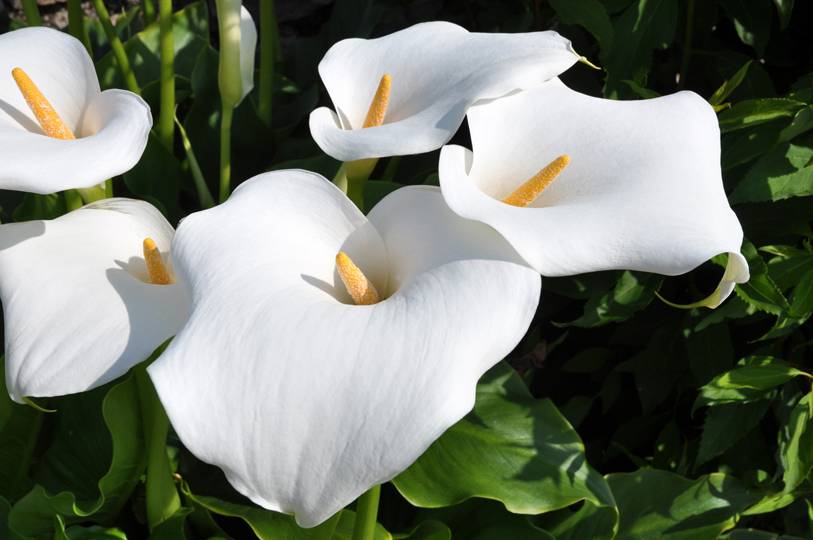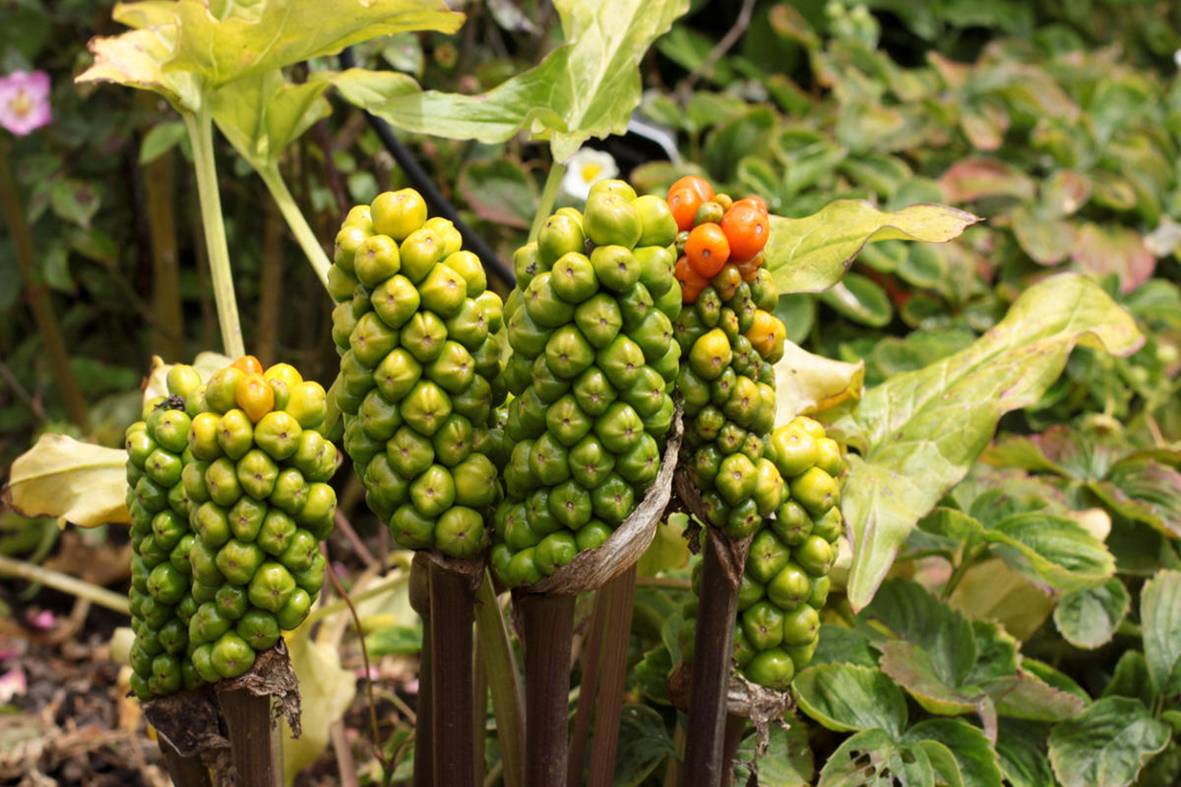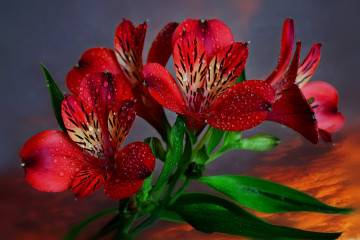Calla flowers - how to plant and care
Content:
Among indoor flowers, there are many quite spectacular and exotic species. One of these species is calla. Flowers of an unusual appearance, and especially inflorescences, attract lovers of indoor floriculture. But many people mistakenly believe that growing calla lilies at home is problematic, and it is almost impossible to achieve flowering. Far from it. Having enough information about this plant, you can safely start growing it at home.
Calla lilies description
Calla lilies naturally grow in South America and Africa. Their size and appearance are somewhat different from indoor species.
Calla indoor is a compact plant with wide glossy leaves, the color of which can be from light to dark green. The inflorescences are a cylindrical ear, as if wrapped in a sheet-shaped blanket. Flowering is long, more than a month.
The color of the bractal leaf differs depending on the type of plant. The shape of the root system also differs, for example, white calla lilies have powerful roots, and colored ones belong to bulbous plants.
Popular types
There are a huge number of varieties of this flower, but the four most popular species are most often used in floriculture.
Calla Eliot
The main difference between this species and others is the color of the leaves, they are covered with small white specks. The color of the leaf itself is dark green.
The bractal leaf has a yellow inner surface and a paler outer with a greenish tinge. In this regard, the plant is referred to as yellow calla.
Lighted windowsills are suitable for growing this species. It is also necessary to maintain high soil moisture.
Ethiopian calla
The most popular classic look. The leaves are powerful, which can reach 60-70 cm in length. The rhizome of the flower is powerful and well developed.
The bractal leaf is white. The inflorescences are often used for cutting into bouquets and for creating various flower arrangements.
Calla Remann
This species can be called miniature, the height of the bush is usually no more than 40-50 cm. The leaves are elongated, oblong, dark green.
A distinctive feature of the species is the shade of the inflorescences, the color of the bedspread is pink-red.
Calla Amethyst
The plant has a powerful and tall bush. It can reach 1-1.2 m. The spectacular bush is striking in its stateliness and size.
The inflorescences are very original. Not only their color, delicate violet, but also their delicate aroma is special. For a long time, this type of calla lilies aroused admiration even for high-ranking ladies.
Growing calla lilies
The first step to successfully growing this exotic flower is to properly plant it in the ground.
Before you start planting, you should pay attention to some important requirements.
- Landing time. It is better to plant calla lilies before the active phase of development of this plant begins. This period falls on the beginning - mid-April.
- Pot size. The root system of calla lilies develops quite quickly, so it is better to choose a pot that is more spacious. Given the peculiarity of the roots to grow more in width than in depth, it is better to choose a container with a large diameter.
- Drainage. Good drainage in the grow tank is imperative. Expanded clay or broken brick should be poured at the bottom of the pot, the layer thickness should be at least 5 cm.
- Soil composition. Calla is a flower that needs nourishing and breathable soil. It should consist of two parts of peat, the same amount of sand and one part of garden soil.
Zantedeschia: home care
Given the fact that calla lilies are native to Africa and South America, we can conclude about the conditions that they need for full growth. A warm and humid climate is key to a successful planting.
To maintain favorable conditions, it is necessary to know how to care for calla lilies and find a suitable place for growing it. Household flowers in a pot of this kind require compliance with a list of certain parameters. Everything you need to consider when caring for calla lilies at home is described below.
Lighting
Calla lilies are very demanding in terms of illumination. These house flowers in a pot are best placed on a light windowsill. Sunlight should be scattered during the day and direct in the evening. Morning scorching rays can be detrimental to the plant. For full development, they need to receive the required amount of light for 12 hours.
It is also necessary to illuminate the plant during the dormant period. After the leaves begin to turn yellow, they put it in a sunny place and gradually reduce watering. Due to sufficient illumination during this period, many root suckers are formed, which must be removed.
Temperature
Like many other plants native to southern countries, calla lilies need a warm climate.
The optimum temperature in summer is 20-22 ° C during the day and 16-18 ° C at night. In winter, it is better to reduce the indicators to 3-4 ° C.
Compliance with the temperature regime is very important, especially in order to get inflorescences. It should also be borne in mind that these flowers do not tolerate drafts and sudden temperature changes. The transition to cooler winter conditions should be carried out gradually.
Humidity
It is this indicator that often causes problems when growing calla lilies. These plants require a very high level of moisture, 70-80% minimum.
To maintain such high performance, you can resort to the following:
- the pot with the plant is placed on a pallet with pebbles or expanded clay. By constantly wetting this pan, a slight increase in humidity can be achieved;
- a more effective way is to use a humidifier. By placing it in the immediate vicinity of the flower, you can increase the humidity to the required level.
Watering
Callas need regular watering. Soil moisture requirements for white calla lilies are different from those needed for colored calla lilies.
The most frequent and abundant watering is needed during the flowering period. After its completion, the degree of moisture is gradually reduced. White calla lilies are watered during dormancy, but colored ones are not.
Top dressing
All types of this flower need regular feeding. They should be applied during the period of active growth and flowering every two weeks.
Indoor calla is very responsive to fertilizing with complex mineral fertilizers. In specialized stores there are ready-made mixtures for this particular type of plant.
Care must be taken when feeding. An excess of minerals can lead to flower disease. Particular attention should be paid to fertilizers containing nitrogen, an excess of this substance can cause the lack of flowering.
Pot size
During the period of active growth, calla lilies quickly build up their root system and consume nutrients from the soil in large quantities. In this regard, it is necessary to periodically change the pot and soil.
Replacing the soil is also necessary when signs of illness are found. In this case, you should resort to an emergency transplant, regardless of the phase of flower development.
Blooming in the apartment
The flowering period of different types of calla lilies is different. White varieties bloom in winter and colored ones in summer. The flowering of this indoor flower can be achieved by observing certain conditions for its maintenance:
- suitable temperature regime;
- timely application of dressings in the right amount;
- providing conditions during the dormant period;
- timely increase and decrease in watering.
The process of growing colored varieties is more like forcing. To achieve flowering, the tuber should be stored in the sand during the dormant period, and planted in the ground in March.
Reproduction at home
There are three ways to breed domestic calla lilies. Each of them has its own advantages and is determined by the type of flower.
Seed propagation
This method is difficult to apply at home and takes a long time. In addition, it is not advisable to wait for the seeds to ripen, since this process requires a lot of energy from the plant.
To obtain seeds, the peduncle is left on the plant until they are formed. After ripening, the seed capsule is cut off and set aside to dry. Before planting, the seeds are germinated on damp gauze and only then are they planted in the ground.
As a rule, this method of propagation is resorted to only if there is a need to grow a plant of a rare variety.
Tuber propagation
For those species of calla lilies that have a tuberous root system, the tuber propagation method is used.
In the process of growth, shoots are formed on the main tuber. When they reach maturity, they can be easily separated and dropped off in a separate container. This procedure can be carried out when laying for storage or when planting tubers in March.
Soil for new plantings should be chosen nutritious and light with a high content of peat and sand. You should also constantly monitor the maintenance of soil moisture.
This breeding method is quite simple and allows you to get a lot of planting material. Under favorable conditions, calla tubers form many processes.
Reproduction by dividing the bush
Most often, flower growers grow white calla lilies, which have a powerful rhizome. It is best to start breeding after flowering.
To get new copies of a flower by this method, during an autumn transplant, the shoots are separated from the main root. Next, they need to be planted in a spacious pot with nutritious soil.
It is necessary to separate young shoots so that as much soil as possible remains on the roots. This will improve their survival rate and further accelerate their growth.
Possible problems and difficulties
Given the exactingness of calla lilies to growing conditions, beginner growers may have a number of difficulties. As a rule, they are associated with care errors.
Non-compliance with the temperature regime
To achieve not only intensive growth, but also flowering, it is necessary to strictly observe the temperature regime. This is due to such a feature of this flower as the need for a dormant period.
It is at this time that the necessary temperature must be provided so that the plant enters this state gradually. Only in this case, further development will end with abundant and prolonged flowering.
Short daylight hours
During flowering, the duration of daylight hours should be 12 hours. Considering that white calla lilies bloom in winter, it is impossible to comply with this condition without additional highlighting of the plants. It is the lack of light that can be the reason why calla lilies do not bloom.
Insufficient or abundant watering
Depending on the type of calla lilies, a certain watering regime is required. Whites water all year round with varying intensities, while colored ones do not need watering during dormant periods.
If there is a lack of moisture, plants will develop poorly and may not bloom. Waterlogging can lead to decay of the roots or tuber, and in the future, to the death of the plant.
Low humidity
The moisture requirements of these southern plants are quite high. In an apartment, especially in winter, it is very difficult to maintain it at the proper level.
If you have a strong desire to grow calla lilies and get them to bloom, it is best to purchase a humidifier. This is the only way to achieve the required level of humidity in winter.
Incorrect soil composition
Callas need light soil as well as plenty of nutrients. With a lack of nutrition, the plants will not have enough strength for full growth and flowering.
Planting in improper soil can lead to depletion and disease of the flower. Also, do not neglect periodic replanting as the plant grows.
Diseases and pests
Calla lilies are susceptible to fungal diseases. At the first signs of illness, changes in the appearance of leaves and flowers, action should be taken immediately. This can be a change in irrigation regime or soil replacement. It is also necessary to carry out treatment with appropriate preparations.
Another problem can be the attack of aphids and thrips. If these pests are found on flowers, it is necessary to immediately treat them with special means.
Callas are spectacular exotic flowers. They can be successfully grown at home and enjoy the amazing flowering of these plants even in winter. Among the variety of species, you can find inflorescences that have both snow white and black. Cultivation of calla lilies seems problematic to many, but this is not entirely true. Providing the plants with proper care and appropriate conditions, you can not only grow them at home, but also multiply them. So do not hesitate for a long time when choosing a zantedeschia flower, caring for it at home will not be difficult.
